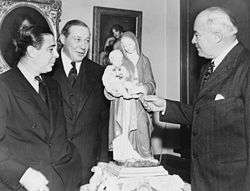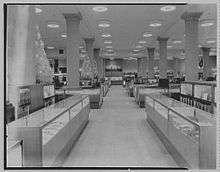Gimbels
 | |
| Industry | Retail |
|---|---|
| Fate | Liquidation |
| Successor | None |
| Founded | 1887 |
| Defunct | 1987 |
| Headquarters | New York, New York, United States |
Key people | Adam L. Gimbel, Bernard Gimbel |
| Products | Clothing, footwear, bedding, furniture, jewelry, beauty products and housewares |
| Parent | Formerly Gimbel Brothers Inc. |
| Subsidiaries | Formerly Saks |
Gimbel Brothers (Gimbels) was an American department store corporation from 1887 until 1987. Adam Gimbel opened the first store in Vincennes, Indiana that would later lead to his son Bernard opening the first store in the chain of Gimbels Department Stores in Milwaukee, Wisconsin.[1]The company is known for creating the Gimbels Thanksgiving Day Parade, the oldest parade in the country. Gimbels was also once the largest department store chain in the country. By the time it closed in 1987, Gimbels had 35 stores in Pennsylvania, New York, New Jersey, Wisconsin, and Connecticut.[1]
History
The company, founded by a young Bavarian Jewish immigrant, Adam Gimbel, began as a general store in Vincennes, Indiana. After a brief stay in Danville, Illinois, Gimbel relocated in 1887 to Milwaukee, Wisconsin, which was then a boomtown. The new store quickly became the leading department store in Milwaukee. However, with seven sons Adam Gimbel saw that one store, no matter how successful, would not accommodate his family's future.
In 1894, Gimbel acquired the Granville Haines store in Philadelphia, Pennsylvania (originally built and operated by Cooper and Conard), and in 1910, opened another branch in New York City. With its arrival in New York, Gimbels prospered, and soon became the primary rival to the leading Herald Square retailer, Macy's, whose flagship store was located a block north. This rivalry entered into the popular argot: "Would Macy's tell Gimbels?" To distinguish itself from Herald Square neighbors, Gimbels' advertising promised more: "Select, don't settle."[2]
Gimbels became so successful that in 1922 the chain went public, offering shares on the New York Stock Exchange (though the family retained a controlling interest). The stock sales provided capital for expansion, starting with the 1923 purchase of across-the-street rival Saks & Co., which operated under the name Saks Thirty-Fourth Street; with ownership of Saks, Gimbel created an uptown branch called Saks Fifth Avenue. In 1925 Gimbels entered the Pittsburgh market with its purchase of Kaufmann & Baer's.[3] Also acquired in this transaction was Gimbels' third radio outlet, WCAE; the company already owned WGBS in New York and WIP in Philadelphia. Although expansion spurred talk of the stores becoming a nationwide chain, the Great Depression ended that prospect. Gimbel did increase the number of more upscale (and enormously profitable) Saks Fifth Avenue stores in the 1930s, opening branches in Chicago, Boston and San Francisco.
Success

.jpg)
By 1930, Gimbels had seven flagship stores throughout the country and net sales of $123 million with 20 sites; this made Gimbel Brothers Inc. the largest department store corporation in the world. By the time of World War II, profits had risen to a net worth of $500 million, or over $8 billion as of 2013.[4] In 1962, Gimbels acquired Milwaukee competitor Schuster's, and in that region operated stores from both chains for a while as Gimbels Schuster's. By 1965, Gimbel Brothers Inc. consisted of 53 stores throughout the country, which included 22 Gimbels, 27 Saks Fifth Avenue stores, and four Saks 34th St.
Gimbels and the middle class
Gimbels principles and merchandise reflect the ideals of middle class America. Their principles consisted of "courtesy, reliability, good value, and enlightened management."[5] By using middle class values Gimbels attracted shoppers to a store that also could fit their budgets. Keeping the store plain and less extravagant than some of its competitors, Gimbels used the slogan "the customer pays for the fans frills."[5] Gimbels was about the product, not the aesthetics. By offering a wide range of cutting edge technology in its merchandise, Gimbels reflected the ideals held by the middle class of staying up to date with technologies and carrying new appliances and merchandise at an affordable price.[6]
Merchandise
Gimbels Department Store offered a variety of merchandise and products, including home appliances, furniture, clothing, and much more. With multiple floors in its flagship stores, each floor offered a given category of merchandise. The Philadelphia Gimbels specifically offered fine jewelry, men's clothing, women's clothing, children's clothing, furniture, toys, art supplies, and appliances for the house. This store also contained The Gimbel Auditorium, Television Headquarters, a salon, and music center. With a wide variety of options Gimbels was a one stop shop that made shopping easy and accessible.

Publicity
Despite its limited presence, Gimbels was well-known nationwide, in part because of the carefully cultivated rivalry with Macy's, but also thanks to an endless stream of publicity. The New York store received considerable attention as the site of the 1939-40 sale of art and antiquities from the William Randolph Hearst collection.[7] Gimbels also gained publicity from the 1947 film Miracle on 34th Street, and from the 1967 film Fitzwilly, and was frequently mentioned as a shopping destination of Lucy Ricardo and Ethel Mertz on the hit 1950s TV series I Love Lucy.
The Slinky made its debut at the northeast Philadelphia Gimbels store.[8] Also, the Philadelphia Gimbels was the first department store in the world to move customers from floor to floor via the escalator.[9]
Parade
The idea of a department-store parade originated in 1920 with Gimbels Department Store in Philadelphia with the parade now known as the 6abc Dunkin' Donuts Thanksgiving Day Parade. The Gimbel family saw the parade as a way to promote holiday shopping at their various store locations.[10] Macy's did not start a parade until 1924. When Gimbels closed down in 1986, television station WPVI took over responsibility for the parade, with sponsorship by Reading, Pennsylvania-based Boscov's. Currently, Dunkin' Donuts is the chief sponsor of the parade.[4]
Store divisions
The Gimbels flagship stores included those in New York City, Philadelphia, Pittsburgh, Milwaukee, Louisville, Boston, and New Jersey.
Flagship store

The Gimbels New York City flagship store was located in the cluster of large department stores that surrounded Herald Square, in Midtown Manhattan. Designed by architect Daniel Burnham, the structure, which once offered 27 acres (110,000 m2) of selling space, has since been modernized and entirely revamped. When this building opened in 1910, a major selling point was its many doors leading to the Herald Square New York City Subway station. Due to such easy access, by the time Gimbels closed in 1986, this store had the highest rate of "shrinkage", or shoplifting losses, in the world.[11] Doors also opened to a pedestrian passage under 32nd Street, connecting Penn Station to the 34th Street (New York City Subway) and 33rd Street (PATH) stations. This Gimbels Passageway was closed in the 1990s for security reasons during a period of high crime rates.
Parts of the former store were occupied by a midtown branch of Brooklyn's Abraham & Straus, and later, by Stern's; the lower two levels are now occupied by JC Penney, in the Manhattan Mall. The building that housed a Gimbels branch at 86th Street and Lexington Avenue remains, but has been converted to apartments.[12]
Pittsburgh flagship

In Pittsburgh, Starrett & van Vleck designed the downtown flagship of the Gimbels Department Store, which was built in 1914 at 339 Sixth Avenue. After Gimbels went out of business in the late 1980s, the building was renamed the Heinz 57 Center.[13] In 1997, it was added to the list of historic landmarks by the Pittsburgh History and Landmarks Foundation.[14]
Relationship to Saks
Saks was founded by Horace Saks in New York City. In 1923, Gimbels purchased Saks, which became a subsidiary of Gimbel Brothers, Incorporated, a publicly traded company. Adam Gimbel, the founder of Gimbels, turned Saks into a national brand. Once BATUS Inc. acquired Gimbel Bros. in 1973 from the Gimbel family, it also owned Saks Fifth Avenue. BATUS closed Gimbels in 1986, and subsequently sold Saks to Investcorp S.A. in 1990.
Acquisition and closure
Gimbels was acquired in 1973 by Brown & Williamson, the American subsidiary of British-American Tobacco, a diversified conglomerate. Brown & Williamson also owned Marshall Field's (purchased in 1982), Frederick & Nelson, The Crescent stores, and Kohl's (purchased in 1972). Brown & Williamson later created the BATUS Retail Group as a subsidiary company for its retail holdings.
BATUS initially left the Gimbels chain in the four autonomous divisions that had been established under Gimbel family ownership: Gimbels New York, Gimbels Philadelphia, Gimbels Pittsburgh, and Gimbels Milwaukee. Each division operated independently of each other in advertising and buying. Each division offered their own credit card which could only be used at Gimbels stores in the same division. In 1983, Gimbels New York and Gimbels Philadelphia were combined into a single entity, Gimbels East, in an attempt to reduce operating losses in both divisions.
Deciding that Gimbels was a marginal performer with little potential for increased profitability, BATUS in 1986 decided to close its Gimbels division and sell its store properties. Some of the more attractive branches were taken over by Stern's (Allied Stores), Pomeroy's (Allied Stores), Kaufmann's (May Department Stores, now part of the corporate family of rival Macy's), or Boston Store (P.A. Bergner & Co.) The cornerstone of the chain, the downtown Milwaukee store where Adam Gimbel had first found success (and alleged to be the most profitable Gimbel store), was handed to BATUS sister division Marshall Field's, but eventually closed in 1997. The downtown Milwaukee building was remodelled in 1998 and now houses a fitness club [15] (formerly a Borders), the headquarters of the American Society for Quality along with other offices, and a 131-room extended stay hotel.[16]
References
- 1 2 "Gimbels Throws In The Discount Towel At Herald Square". tribunedigital-chicagotribune. Retrieved 2017-05-01.
- ↑ Bernheimer, Kathryn. "NY Trivia: Would Gimbels Tell Macy’s?". Boulder Jewish News.
- ↑ "The Vindicator - Google News Archive Search".
- 1 2 "Bernard Gimbel, A Force Behind Thanksgiving Parade". Investor's Business Daily. 2013-11-27. Retrieved 2016-11-18.
- 1 2 Smith, Scott S. (2013-11-27). "Bernard Gimbel, A Force Behind Thanksgiving Parade". Investor's Business Daily. Retrieved 2017-04-27.
- ↑ Hepp IV, John (2003). The Middle Class City: Transforming Space and Time in Philadelphia 1876-1926. University of Pennsylvania. p. 148.
- ↑ Whitaker, Jan (2007). Service and Style: How the American Department Store Fashioned the Middle Class. St. Martin's Press.
- ↑ Townsend, Allie (2011-02-16). "All-TIME 100 Greatest Toys - TIME". Time. ISSN 0040-781X. Retrieved 2017-05-02.
- ↑ Couch, Ernie and Couch, Jill. Pennsylvania Trivia. Nashville: Rutledge Hill Press, 1995, p.190
- ↑ Smith, Scott S. (2013-11-27). "Bernard Gimbel, A Force Behind Thanksgiving Parade". Investor's Business Daily. Retrieved 2017-05-02.
- ↑ Shulkin M.D, Mark Weiss (2011). 100 Years In America: A History of a Jewish Family a Century After Immigration. iUniverse.
- ↑ Scardino, Albert (1986-06-07). "GIMBELS AT 86th: A BORN LOSER". The New York Times. ISSN 0362-4331. Retrieved 2017-05-02.
- ↑ "Oxford Development Company". www.oxforddevelopment.com. Retrieved 2017-05-03.
- ↑ "Protest Against Gimbels Department Store, 1935". Clio. Retrieved 2017-05-03.
- ↑ Daykin, Tom. "Former downtown Borders lands Planet Fitness".
- ↑ "Residence Inn Milwaukee Downtown". Marriott. Retrieved April 5, 2014.
Bibliography
- Ferry, John William. A History of the Department Store. New York: The Macmillan Company, 1960.
- Harris, Leon. Merchant Princes. New York: Harper & Row, 1979.
- Lisicky, Michael. "Gimbels Has It!". Charleston: The History Press, 2011.
- Mahoney, Tom, and Sloane, Leonard. The Great Merchants: America's Foremost Retail Institutions and the People Who Made Them Great. New York: Harper & Row, 1974.
